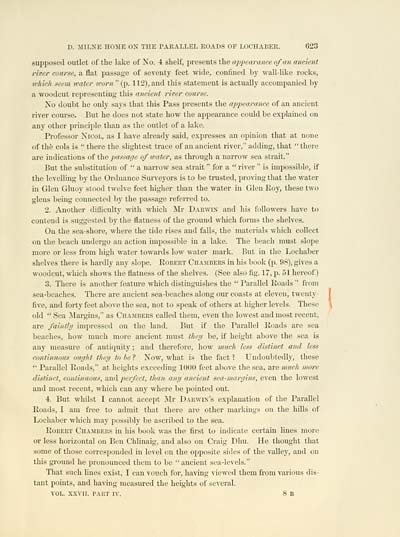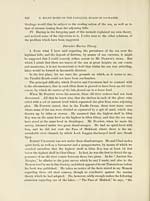Download files
Complete book:
Individual page:
Thumbnail gallery: Grid view | List view

D. MIL^'E HOME ON THE PARALLEL ROADS OF LOCHABEE. 623
supposed outlet of the lake of Xo. 4 shelf, presents the appearance of an ancient
riter course, a flat passage of seventy feet wide, confined by wall-like rocks,
H'/tic/i seem water irorn" (p. 112), and this statement is actually accompanied by
a woodcut representing this ancient river course.
No doubt he only says that this Pass presents the appearance of an ancient
river com'se. But he does not state how the appearance could be explained on
any other principle than as the outlet of a lake.
Pi'ofessor Xicol, as I have already said, expresses an (_)pinion that at none
of the cols is " there the slightest trace of an ancient river," adding, that " there
are indications of the ^^ff^.'^ayt' of water, as through a narrow sea strait."
But the substitution of " a narrow sea strait " for a " river " is impossible, if
the levelling by the Ordnance Surveyors is to be trusted, proving that the water
in Glen Gluoy stood twelve feet higher than the Avater in Glen Roy, these two
glens being connected by the passage referred to.
2. Another difficulty with which jSIr Darwin and his followers have to
contend is suggested by the flatness of the ground which forms the shelves.
On the sea-shore, where the tide rises and falls, the materials which collect
on the beach undergo an action impossible in a lake. The beach must slope
more or less from high water towards low water mark. But in the Lochaber
shelves there is hardly any slope. Robert Chambers in his book (p. 98), gives a
woodcut, which shows the flatness of the shelves. (See also fig. 17, p. 51 hereof.)
3. There is another feature which distinguishes the " Parallel Roads " from
sea-beaches. There are ancient sea-beaches along our coasts at eleven, twenty-
five, and forty feet above the sea, not to speak of othei\s at higher levels. These
old " Sea ^Margins," as Chambers called them, even the lowest and most recent,
are faintly impressed on the land. But if the Parallel Roads are sea
beaches, how much more ancient must theii be, if height above the sea is
any measure of antiquity ; and therefore, how much less distinct and less
continuous ought they to he? Xow, what is the fact? Undoubtedly, these
" Parallel Roads," at heights exceeding 1000 feet above the sea, are much more
distinct, continuous, and j^erfect, than any ancient sea-margins, even the lowest
and most recent, which can any where be pointed out.
4. But whilst I cannot accept Mr Darwin's explanation of the Parallel
Roads, I am free to admit that there are other markings on the hills of
Lochaber which may jDossibly be ascribed to the sea.
Robert Chambers in his book was the first to indicate certain lines more
or less horizontal on Ben ChUnaig, and also on Craig Dhu. He thought that
some of those corresponded in level on the opposite sides of the valley, and on
this ground he pronounced them to be " ancient sea-levels."
That such lines exist, I can vouch for, having viewed them from various dis-
tant points, and having measured the heights of several.
VOL. XXVII. PART IV. 8 B
supposed outlet of the lake of Xo. 4 shelf, presents the appearance of an ancient
riter course, a flat passage of seventy feet wide, confined by wall-like rocks,
H'/tic/i seem water irorn" (p. 112), and this statement is actually accompanied by
a woodcut representing this ancient river course.
No doubt he only says that this Pass presents the appearance of an ancient
river com'se. But he does not state how the appearance could be explained on
any other principle than as the outlet of a lake.
Pi'ofessor Xicol, as I have already said, expresses an (_)pinion that at none
of the cols is " there the slightest trace of an ancient river," adding, that " there
are indications of the ^^ff^.'^ayt' of water, as through a narrow sea strait."
But the substitution of " a narrow sea strait " for a " river " is impossible, if
the levelling by the Ordnance Surveyors is to be trusted, proving that the water
in Glen Gluoy stood twelve feet higher than the Avater in Glen Roy, these two
glens being connected by the passage referred to.
2. Another difficulty with which jSIr Darwin and his followers have to
contend is suggested by the flatness of the ground which forms the shelves.
On the sea-shore, where the tide rises and falls, the materials which collect
on the beach undergo an action impossible in a lake. The beach must slope
more or less from high water towards low water mark. But in the Lochaber
shelves there is hardly any slope. Robert Chambers in his book (p. 98), gives a
woodcut, which shows the flatness of the shelves. (See also fig. 17, p. 51 hereof.)
3. There is another feature which distinguishes the " Parallel Roads " from
sea-beaches. There are ancient sea-beaches along our coasts at eleven, twenty-
five, and forty feet above the sea, not to speak of othei\s at higher levels. These
old " Sea ^Margins," as Chambers called them, even the lowest and most recent,
are faintly impressed on the land. But if the Parallel Roads are sea
beaches, how much more ancient must theii be, if height above the sea is
any measure of antiquity ; and therefore, how much less distinct and less
continuous ought they to he? Xow, what is the fact? Undoubtedly, these
" Parallel Roads," at heights exceeding 1000 feet above the sea, are much more
distinct, continuous, and j^erfect, than any ancient sea-margins, even the lowest
and most recent, which can any where be pointed out.
4. But whilst I cannot accept Mr Darwin's explanation of the Parallel
Roads, I am free to admit that there are other markings on the hills of
Lochaber which may jDossibly be ascribed to the sea.
Robert Chambers in his book was the first to indicate certain lines more
or less horizontal on Ben ChUnaig, and also on Craig Dhu. He thought that
some of those corresponded in level on the opposite sides of the valley, and on
this ground he pronounced them to be " ancient sea-levels."
That such lines exist, I can vouch for, having viewed them from various dis-
tant points, and having measured the heights of several.
VOL. XXVII. PART IV. 8 B
Set display mode to: Large image | Transcription
Images and transcriptions on this page, including medium image downloads, may be used under the Creative Commons Attribution 4.0 International Licence unless otherwise stated. ![]()
| Early Gaelic Book Collections > J. F. Campbell Collection > On the parallel roads of Lochaber > (47) |
|---|
| Permanent URL | https://digital.nls.uk/80970574 |
|---|
| Description | Volumes from a collection of 610 books rich in Highland folklore, Ossianic literature and other Celtic subjects. Many of the books annotated by John Francis Campbell of Islay, who assembled the collection. |
|---|
| Description | Selected items from five 'Special and Named Printed Collections'. Includes books in Gaelic and other Celtic languages, works about the Gaels, their languages, literature, culture and history. |
|---|

